28. When the coffee trees are planted the work is not finished.
The grower still has a lot of work to do to look after
his coffee trees.
A grower who does not look after his plantation
properly cannot get a good harvest of berries and
will not earn much money.
To look after your plantation properly, you must:
replace seedlings that have not grown,
keep the soil covered and remove weeds,
prune the coffee trees correctly,
apply fertilizers,
protect the coffee trees from insects and diseases.
29. Sometimes certain coffee seedlings do not grow well.
They remain small or die.
During the months after planting, you must look often
to see whether your coffee trees are growing well.
If you see diseased or dead coffee trees, pull them
out and burn them.
In their place, plant other coffee seedlings from among
those you have kept in the nursery.
30. Between the rows of coffee trees the soil must always
be covered either by palm fronds or cut weeds, or by
a cover crop.
Palm fronds and cut weeds keep the soil moist and
protect it against erosion.
If you have a cover crop, make sure it covers the whole
of the soil.
But sometimes cover plants climb on the coffee trees.
In that case, cut down those plants that wind around
the trunk and branches of the coffee tree.
31. Weeds often grow among the coffee tree rows.
Do not let the weeds take the nourishment away.
Hoe often but, when hoeing, be very careful not to
damage the trunk and roots of the coffee trees.
Why coffee trees need pruning
32. The coffee tree grows too fast.
During the first few years, the tree makes many
branches: it uses all its nourishment to make wood.
At the first harvest, the tree yields a lot of berries.
But the coffee tree ages very quickly.
The coffee tree uses all the mineral salts of the soil
in order to feed the wood of the branches.
It can no longer yield a lot of berries.
Therefore the coffee tree must be pruned so that It
does not make too many branches.
The coffee tree does not develop well.
The branches of the coffee tree grow all over the
place.
The coffee tree is not well-shaped and not strong.
Therefore the coffee tree must be pruned to give it
a good shape.
The coffee tree grows too tall.
The coffee tree may grow to 10 or 15 metres.
It is then not easy for the grower to pick the berries.
Therefore the coffee tree must be pruned so that it
is not too tall.
Every variety of coffee tree needs different pruning.
33. Trees of Arabica, Liberica, Gros Indénié and Excelsa
coffee have only one main stem: one trunk only.
The berries grow for several years on all parts of
the branches.
Pruning these coffee trees is simple:
Cut off the top of the tree so that the coffee tree is not taller than 1.5 to 2 metres.
Remove the branches at the bottom of the trunk.
Leave only the thickest and best branches on the trunk.
Cut away all the small branches that grow on the trunk.
Cut away all the dead and dry branches, and all diseased branches.
Cut away suckers; they are not needed.

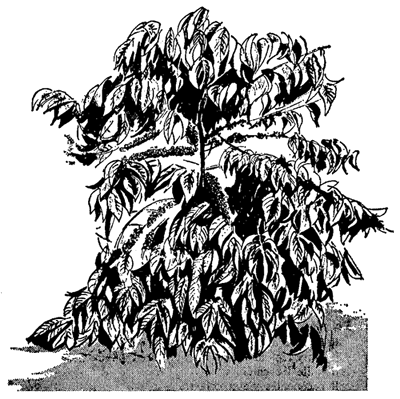
Kouilou coffee tree
34. Trees of the Robusta, Kouilou and Petit Indénié varieties have several main stems: several trunks.
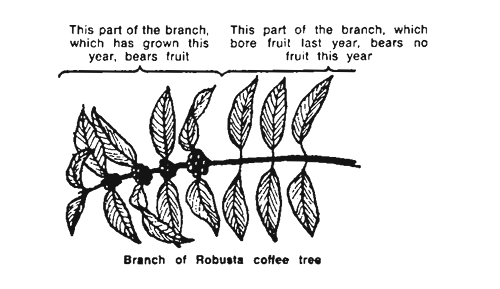
The wood of a branch has berries only for one year.
The next year, that part of the branch bears no fruit.
The berries grow on the new wood which has grown
during the year.
A branch yields fruit for several years, but it is always
a different part of the branch that bears fruit.
Pruning these coffee trees is difficult:
Bend down the first stem and tie it to a stake.

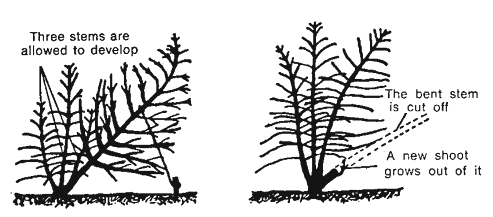
Let three to five main stems develop: they will bear fruit.
Cut off the bent stem: a new stem will grow in its place.
On the main stems, branches will grow and bear
fruit.
After two years of harvests, fruit will grow only
on the tips of the branches: cut down these
branches.
When a main stem has borne fruit for three to five
years, cut it off.
In the place of the stem you cut off, a new stem
or shoot will grow and bear fruit.
Every year cut off one of the main stems.
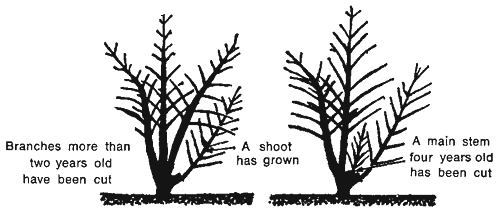
Cut away suckers.
A sucker is a twig that grows upward out of a
main stem.
A sucker never bears fruit.
Cut away also all dry or dead branches.
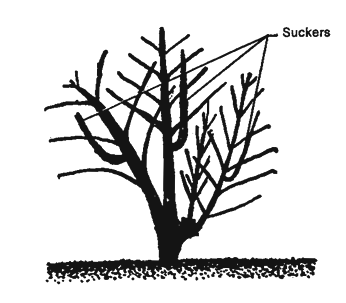

35. When coffee trees in a plantation get too old they no longer yield many berries and do not bring in much money.
To make your coffee trees young again, cut them back:
Leave on the trunk only one main stem; cut off all the others. New stems will grow in the place of the stems you cut off.
When the new stems have grown, cut off the old stem you have left on the trunk. The tree becomes young again and bears a lot of berries.
Cutting back should be done at the beginning
of the rainy season.
After cutting back, apply fertilizer.

Fertilizers cost a lot of money.
Use fertilizers only when this will earn a lot of money.
36. It is useless to apply fertilizer in a plantation that is
not well looked after.
If you do not prune your coffee trees, and you do
not hoe, then you should not apply any fertilizer.
The fertilizer would do nothing except feed the wood
of the branches and the weeds.
When you have pruned your coffee trees well, when
you have hoed up the weeds, then apply fertilizer.
Coffee trees need a lot of potash, a lot of nitrogen,
and a little phosphoric acid.
Spread the fertilizer in a ring around each coffee tree,
but be very careful not to put any on its trunk,
branches or leaves.
If you do, the fertilizer will burn the coffee tree.
Spread the fertilizer at a distance of about 1 metre
from the trunk.
Apply fertilizer several times a year (except for dicalcium
phosphate, only once a year).
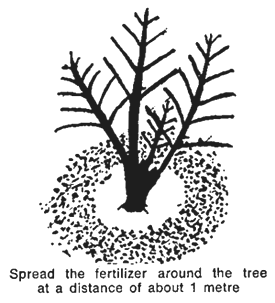
37. Different soils have different fertilizer needs. For example, in the Ivory Coast:
On the more sandy soils, along the coast, apply to each coffee tree:
in March: 50 g ammonium sulfate
50 g dicalcium phosphate
40 g potassium sulfate
in July: 30 g ammonium sulfate
40 g potassium sulfate
in October: 30 g ammonium sulfate
40 g potassium sulfate
On the more granitic soils of the interior, apply to each coffee tree:
in March: 30 g ammonium sulfate
50 g dicalcium phosphate
30 g potassium sulfate
in July: 20 g ammonium sulfate
40 g potassium sulfate
in October: 20 g ammonium sulfate
30 g potassium sulfate
The most dangerous enemies of the coffee tree are:
38. Coffee stem borers
The larvae of these insects bore holes in the stems and so ruin the coffee trees. So you must:
Pull up and burn affected trees.
Try to catch these insects and kill them.
You can control borers with Dieldrin.

39. Coffee berry borer
These insects lay their eggs in the coffee beans. The
berries turn black.
Remove the black berries and burn them.
Pick up all the berries that have dropped to the ground
and burn them.
You can control the coffee berry borer with endrin.
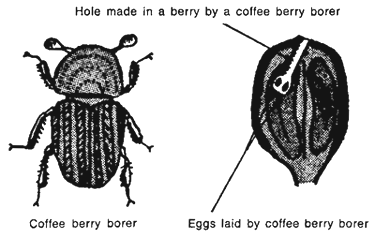
40. Tracheomycosis
This is the most dangerous disease of the coffee tree.
It has caused great damage to the coffee plantations
of the Ivory Coast.
It comes from a fungus which attacks the stems and
branches.
The trees dry out and die.
To control this disease, pull up the diseased trees
and burn them.
There are many other diseases, for instance:
Coffee leaf disease
The leaves, branches and fruit become dry.
Cut off the diseased parts and burn them.
Berry rot
The berries become brown, then dry.
Pick them and burn them.
There are also many other insects:
Green scale on the branches
Thrips
Leaf caterpillars
Always burn diseased trees, diseased branches, diseased berries.
Look for insects and kill them.